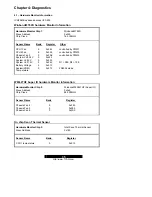
43
http://www.TYAN.com
PCI (Peripheral Component Interconnect):
a 32 or 64-bit local bus (data pathway) which is
faster than the ISA bus. Local buses are those which operate within a single system (as opposed
to a network bus, which connects multiple systems).
PCI PIO (PCI Programmable Input/Output) modes:
the data transfer modes used by IDE drives.
These modes use the CPU for data transfer (in contrast, DMA channels do not). PCI refers to the
type of bus used by these modes to communicate with the CPU.
PCI-t o-PCI bridge:
allows you to connect multiple PCI devices onto one PCI slo t.
Pipeline burst SRAM:
a fast secondary cache. It is used as a secondary cache because SRAM
is slower than SDRAM, but usually larger. Data is cached first to the faster primary cache, and
then, when the primary cache is full, to the slower secondary cache.
Pipelining:
improves system performance by allowing the CPU to begin executing a second
instruction before the first is completed. A pipeline can be likened to an assembly line, with a given
part of the pipeline repeatedly executing a set part of an op eration on a series of instructions.
PM timers (Power Management timers):
software timers that count down the number of
seconds or minutes until the system times out and enters sleep, suspend, or doze mode.
PnP (Plug- n-Play):
a design standard that has become ascendant in the industry. Plug -n -Play
devices require little set-up to use. Novice end users can simply plug them into a computer that is
running on a Plug-n -Play aware operating system (such as Windows 98), and go to work. Devices
and operating sys tems that are not Plug-n-Play require you to reconfigure your system each time
you add or change any part of your hardware.
PXE (Preboot Execution Environment):
one of four components that together make up the
Wired for Management 2.0 baseline specificati on. PXE was designed to define a standard set of
preboot protocol services within a client, towards the goal of allowing networked -based booting to
boot using industry standard protocols.
RAID (Redundant Array of Independent Disks):
a way for the same data to be stored in
different places on many hard drives. By using this method, the data is stored redundantly, also
the multiple hard drives will appear as a single drive to the operating system. RAID level 0 is
known as striping, where data is striped (or overlapped) across multiple hard drives, but offers no
fault-tolerance. RAID level 1 is known as mirroring, which stores the data within at least two hard
drives, but does not stripe. RAID level 1 also allows for faster access time and fault-tolerance,
since either hard drive can be read at the same time. RAID level 0+1 is both striping and
mirroring, providing fault-tolerance, striping, and faster access all at the same time.
RAIDIOS: RAID I/O Steering (Intel)
RAM (Random Access Memory):
technically refers to a type of memory where any byte can be
accessed without touching the adjacent data, is often used to refer to the system’s main memory.
This memory is available to any program running on the computer.
ROM (Read-Only Memory):
a storage chip which contains the BIOS; the basic instructions
required to boot the computer and start up the operating system.
SDRAM (Synchronous Dynamic RAM):
called as such because it can keep two sets of memory
addresses open simultaneously. By transferring data alternately from one set of addresses and
then the other, SDRAM cuts down on the delays associated with non -synchronous RAM, which
must close one address bank before opening the next.
Serial port:
called as such because it transmits the eight bits of a byte of data along one wire, and
receives data on another single wire (that is, the data is transmitted in serial form, one bit after
another).




































